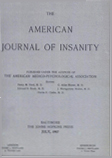CLINICAL AND ELECTROENCEPHALOGRAPHIC STUDIES IN PYKNOLEPSY
Abstract
Eight cases of typical pyknolepsy are presented. Four of these ceased spontaneously during the period of observation.
Clinically they were similar to petit mal epilepsy except for the mildness of their symptoms, the fairly monotonous course, their lack of deterioration and the tendency to spontaneous cure.
Electroencephalographic studies were made on three of these cases after they had ceased, four during their still active phase, and one before and after cessation of the attacks. Normal brain potentials were found in the spontaneously recovered cases whereas in the active ones typical petit mal electrical patterns were observed.
From the study of these eight cases it appears that pyknolepsy is a form of petit mal epilepsy because of:
1. The similarity in the clinical picture;
2. The electroencephalographic pattern in the active phase showing a wave and spike formation found in petit mal epilepsy;
3. The lack of evidence of definite psychogenic factors;
4. The high incidence of epilepsy in families of patients with pyknolepsy as revealed by a study of the literature.
Access content
To read the fulltext, please use one of the options below to sign in or purchase access.- Personal login
- Institutional Login
- Sign in via OpenAthens
- Register for access
-
Please login/register if you wish to pair your device and check access availability.
Not a subscriber?
PsychiatryOnline subscription options offer access to the DSM-5 library, books, journals, CME, and patient resources. This all-in-one virtual library provides psychiatrists and mental health professionals with key resources for diagnosis, treatment, research, and professional development.
Need more help? PsychiatryOnline Customer Service may be reached by emailing [email protected] or by calling 800-368-5777 (in the U.S.) or 703-907-7322 (outside the U.S.).



